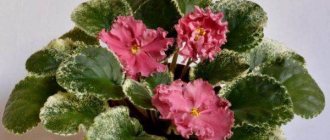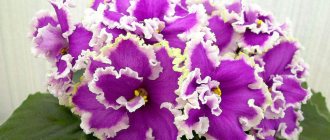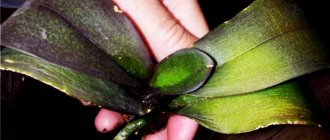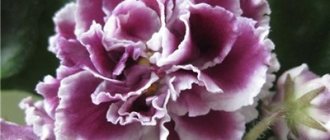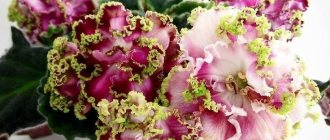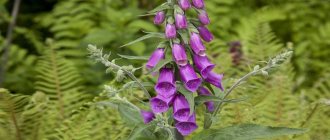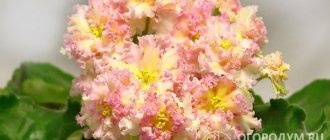Description
This plant variety is one of the most beautiful and rare. This is due to the fact that its flowers have the ability to change their color depending on growing conditions.
History of the variety, who bred it
Frosty cherry was bred in 2005 by the famous breeder Konstantin Morev. In order to achieve perfection, he worked on creating this uniquely beautiful variety for more than 11 years.
Leaves
The Frost Cherry rosette consists of pointed, simple, oval, standard-sized leaves. The leaf blade is covered with delicate villi. As for the color of the leaves, it changes with age: young leaves are painted a soft green color, and as they get older, their color gradually changes to dark green.
Flowers
The real decoration of violets of the Frosty Cherry variety are their beautiful flowers. Their diameter ranges from 4 to 5 mm. If the plant blooms for the first year, its flowers are smaller. In the second and third years of flowering it increases. The petals have a terry covering.
The color scheme is based on a rich cherry color, along the edge of which there is a wide white stripe. The central part of the flower is white. In the central part of the flower there are yellow stamens.
Differences from other varieties
A distinctive feature of the Frosty Cherry variety violet is that over time the color of the petals tends to change: sometimes it becomes saturated, sometimes it fades.
The change in color depends on many factors, for example, on the temperature of the room where the container with the plant is located: when the temperature rises, the color of the petals becomes deep red, and when the air temperature drops, the petals become pale pink.
Among the factors influencing the color intensity are also the flowering period of the plant, stability and level of lighting, and time of year.
It is also worth noting that the flowering period of violets of this variety begins quite early.
Reviews
Ananstasia. “My winter cherry blossomed in the spring, the flowers did not dry out for a long time and did not fall off. I really liked this variety, the color is so bright and tasty. Although it floats a lot in the heat, in winter and spring the flowers are just a sight for sore eyes.”
Regina. “I really love all the varieties of Konstantin Morev, they always have more flowers than leaves! And Frosty Cherry is a fairy tale! The flower stalks grow all at the same time, the rosette almost forms itself. And even in the heat, when I was throwing out other violets by the armfuls, the Frosty Cherry variety coped, only there was a little more red. The variety is very resistant and tenacious.”
This violet attracts the attention of many gardeners.
Photo of the variety “Frosty Cherry”
Possible problems
Like any home flower, violet is subject to some diseases. The plant gets sick mainly due to improper care. If you correct it, the problem will disappear:
- the roots begin to rot, the leaves fade - too much fertilizer, too large a pot, insufficient temperature or cold water for irrigation;
- leaf blades turn yellow - lack of watering or fertilizers;
- spots appear on the leaves - they have been exposed to water, sunburn and the presence of a draft are possible;
- flowers fall off - excess fertilizer.
If grayish mold appears on the violet, it means that it is affected by gray rot. Its occurrence is caused by low temperature and too high humidity. Diseased parts of the plant are removed, and the rest are treated with fungicides.
A whitish coating on flowers or leaves indicates the presence of powdery mildew. It appears due to dust formation, poor lighting, imbalance of temperature and humidity, as well as incorrect ratios of minerals. The fight against this disease consists of washing the earthen clod with hot water and disinfecting with fungicides.
Pests that damage violets include mites, thrips and scale insects. For protection purposes, the plant is washed with a strong soap solution and treated with special preparations.
You can learn more about the “Spring” violet in the following video.
Growing conditions
Violet Frosty cherry is a light- and heat-loving plant. In order to achieve the flowering characteristic of plants of this variety, it is necessary to observe certain growing conditions.
Priming
To grow violets, it is recommended to use special soil, which can be purchased at a flower shop. But you can prepare the soil yourself. To do this, you need to use the following components:
- turf soil;
- peat;
- leaf soil;
- needles;
- raising agents.
If we are talking about soil that is used for rooting cuttings, to prepare it, you can mix equal parts cultivator and peat.
Pot
To grow violets, it is better to use small plastic containers. Plants do not like large diameter pots. This is due to the fact that its roots are located in the upper part of the soil. It is necessary to make small holes in the bottom of the container to allow excess liquid to drain.
Important! If there are no such holes, it is possible that excess moisture will accumulate in the soil, which will lead to rotting of the root system.
Lighting
Frosty cherry is a light-loving plant: its daylight hours should not be less than 12 hours. In winter and autumn, plants need additional lighting.
If the violet does not receive enough light, its leaves gradually droop down. When direct rays of the sun hit the leaf blades, burns will form on them, which will appear in the video of brown spots.
The shape of the Frosty Cherry bush also depends on the amount of incoming light. When there is insufficient lighting, the cuttings of the leaves are stretched and turned towards the light. If there is excess lighting, they are located closer to the central part of the outlet.
Temperature
This variety of violet is extremely demanding on temperature conditions. For growth and development, this figure can be within 10 – 16 degrees. For the active flowering period to begin, the room temperature should be from 20 to 26 degrees.
Important! If the temperature drops to 5 or rises above 30 degrees, the plant will simply die!
There should be no drafts in the place where the pots with violets are located. This has a negative effect on Frost Cherry blossoms.
Humidity
The watering regime is no less important for violets. When overwatering, there is a high probability of death of the entire plant. If the soil ball is dry, this affects the appearance of the leaves: they wither and droop.
As for the water temperature, it should not be cold. The most optimal water for watering Frosty cherries is considered to be at room temperature.
It is necessary to water the soil along the edge of the pot. Excess liquid will flow out through the holes in the container and remain in the pan. 1 - 2 hours after watering, excess water from the pan must be drained, preventing it from stagnating.
How to form a bush correctly
For preventive pruning, old dried leaves and faded buds are removed.
Lateral layers—stepchildren—are also plucked to prevent thickening of the crown.
Adult, overgrown violets also need to form a bush.
Their lower leaves usually grow strongly on the sides, the peduncles become elongated, which spoils the overall impression of the appearance of the plant.
Complete pruning of the lower leaves can solve this problem. A rejuvenation method is also suitable, in which the upper rosette of the violet is cut and rooted in order to obtain a new plant.
Violets of the RM Royal Lace variety are one of the most beautiful representatives of their species. With proper care, they can become a worthy addition to the most sophisticated collections of these indoor plants.
It will be useful for owners of most popular varieties, for example Saintpaulia “Duchess”.
Planting and propagation
To preserve maternal characteristics, Frosty cherry is recommended to be propagated by cuttings. To do this, a healthy and durable leaf is cut off at the root. Then it is placed in a cool place (refrigerator) for 2 - 3 hours. During this time, you can prepare the pot and container.
The diameter of the planting container should not be more than 6 cm. This promotes active growth of the root system.
It is better to prepare the soil mixture yourself by mixing garden soil, peat and sand (3: 3: 1).
The cutting goes deep into the soil to a depth of 2 - 2.5 cm. After this, the sheet is covered with a glass jar. After 30 - 40 days, the first cutting will take root.
Interesting facts about violets:
- Despite some similarities between the flowers of garden violet (Viola) and indoor violet (Saintpaulia), they belong to completely different families.
- The very first Usambara violets appeared in Europe in 1893, and in the late 20s of the 20th century this plant conquered the United States of America.
- In Saintpaulias growing in natural conditions, the leaves do not differ much from each other. In hybrid varieties, two types of leaves are observed: “fight” and “girl”. The female leaf has a compaction and a cream-colored spot at the base. There are much more hybrids with male leaves than with female leaves.
- Professionals have long tried to develop a variety of violets with yellow flowers. This was complicated by the fact that Saintpaulias do not have the gene responsible for this color. But in 1989, an American breeder managed to develop a variety with a stable yellow color.
- The home flower violet has a powerful positive aura. Its subtle aroma stabilizes heart rhythms, increases the body's immunity and has a beneficial effect on a person's mental state.
Care
For normal growth and development of the Frost Cherry, it needs to be provided with certain care. Otherwise, the plant will grow slowly and the flowering period may not occur.
Watering
The plant does not tolerate waterlogged soil and drought. It is recommended to water violets as the soil dries. Excess liquid, which is removed through the drainage holes, is removed after each watering.
Transfer
An adult plant must be replanted twice throughout the year. This must be done with a lump of old earth, carefully removing it from the old container.
If there are no signs of disease on the plant, the old soil is not replaced with new soil, but only added to a new pot of larger diameter.
If there is the slightest sign of disease, the old soil is carefully shaken off the root system. To disinfect the roots, I place them in a weak solution of potassium permanganate for 10–20 minutes.
Bloom
Violet winter cherry
Not greedy for flowering, the Winter and Frosty cherry varieties delight with beautiful flowers almost all year round. In winter, it is recommended to create a dormant period for a couple of months, reduce watering and not add additional light.
After this, you need to create favorable conditions for growth - and soon an elegant bouquet will be formed. Peduncles appear in the axils of the leaves, each bearing several flowers. Mature plants are prone to cap flowering.
To extend the flowering time, do not forget a few simple rules:
- It is important to provide the violet with good lighting. With a lack of light, the flowers fade, and the leaves and peduncles become elongated.
- Wilted flower stalks need to be removed.
- For flowering plants, the daylight hours should be 12 hours.
- During budding and flowering, violets need fertilizing and frequent watering.
Fertilizer and feeding
This variety of violets does not respond well to dense and overly nutritious soils. This can lead to slower growth of the plant, loss of attractiveness, and stopping the flowering process.
As a top dressing, it is better to use special fertilizers, which can be purchased at flower shops. You should not fertilize Frosty cherry more than 1 - 2 times over 30 days.
Pest prevention
Preventative measures against parasite attacks include compliance with all necessary growing conditions. It is necessary to regularly inspect leaves and flowers.
If the plant is attacked by nematodes or clover cutworms, then treatment should be carried out already at the initial stage of infection. At this point, you can still use traditional methods. If there are a lot of insects, you can only get rid of them with the help of chemicals.
Can it be planted indoors?
The white forest violet, like other types of wild flowers, is very difficult to tolerate indoor conditions. They need a wide area to grow. In a small pot, the root system will rot. This will lead to death.
